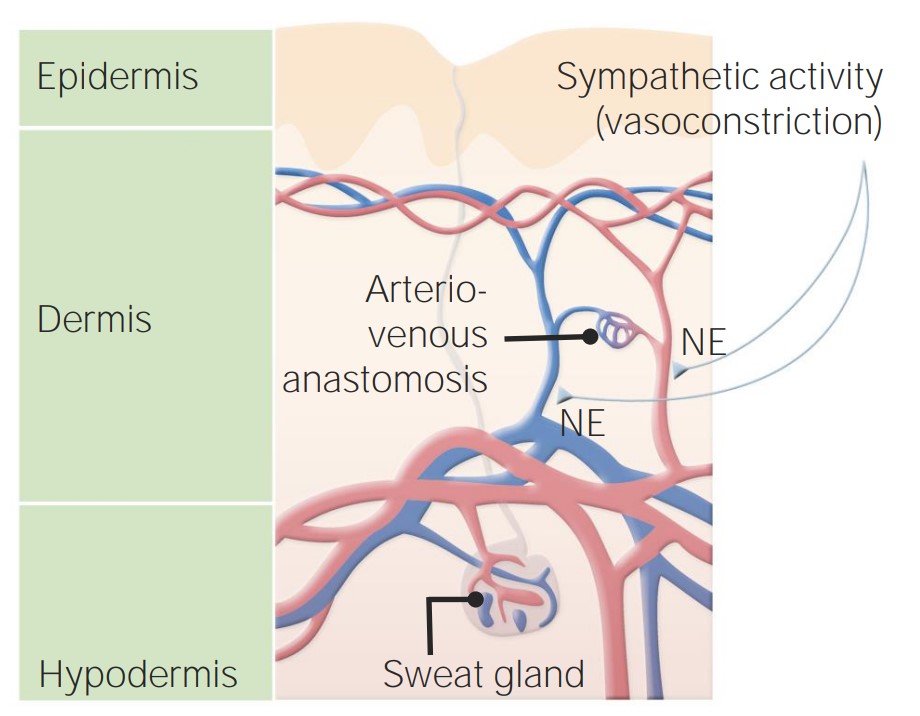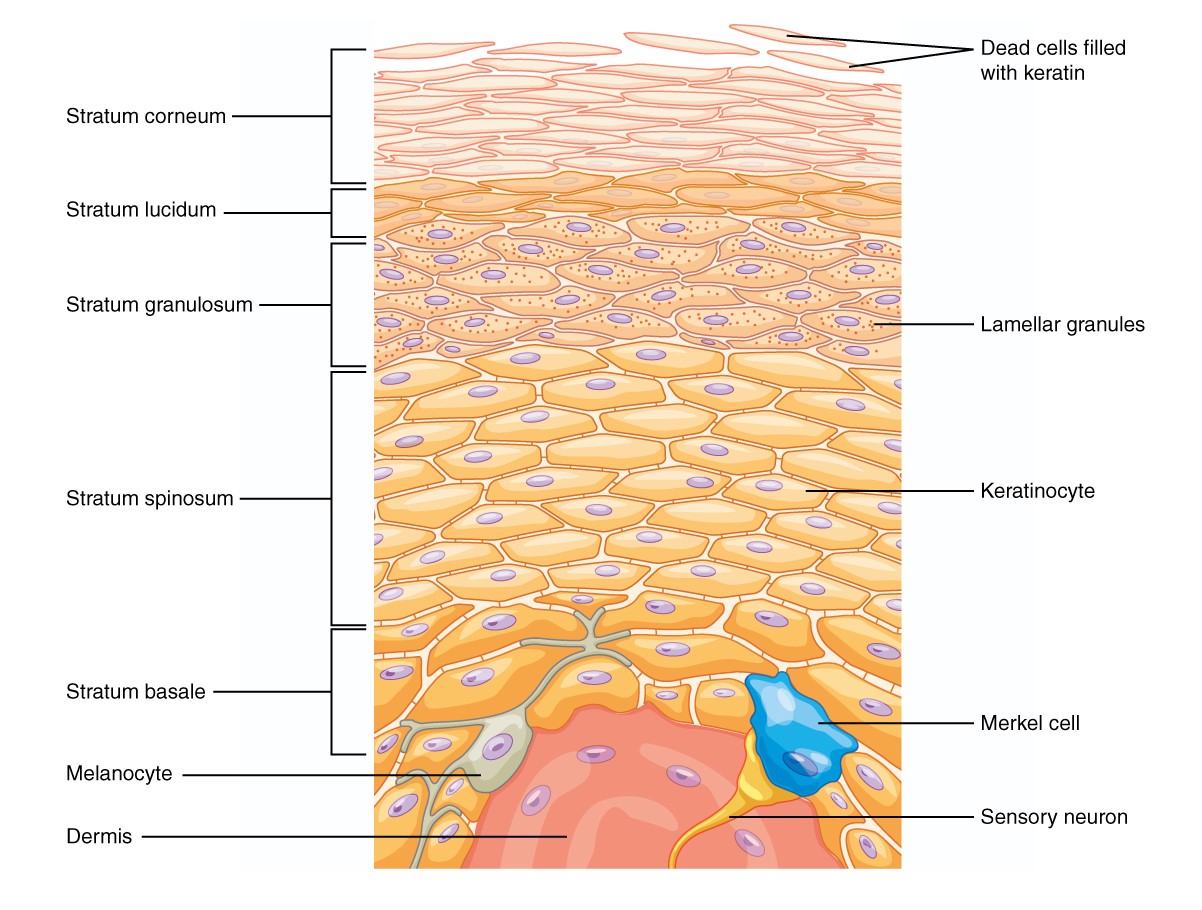Playlist
Show Playlist
Hide Playlist
Cutaneous Circulation – Special Circulations
-
Slides SpecialCirculations VascularPhysiology.pdf
-
Download Lecture Overview
00:00 We also want to think about the cutaneous circulation. Skin circulation is very important for dissipating heat. So if you're out on a hot day you'll need to vasodilate the skin in order for you to thermoregulate. If you didn't thermoregulate you would overheat, you get heat exhaustion, heat stroke and could die. To look at the control of skin blood flow, however, we have to break apart the different types of skin. Non-glabrous skin is what is hairy skin, skin that has hair on it and we're going to contrast that to glabrous skin which is skin that does not have hair on it such as the palms, the ears, sometimes the nose and those areas are controlled a little bit differently but let's talk about non-glabrous skin first. In resting condition, skin blood flow is fairly low and stable. In response to a cold stress, the sympathetic nervous system is activated and this will cause a vasoconstriction. This vasoconstriction is mediated through alpha 1 and alpha 2 adrenergic receptors. So this is the release of norepinephrine causing these responses. The other neurotransmitter that is important is neuropeptide Y. It is also released by noradrenergic nerve terminals. In response to heat, you will first release vasoconstriction and then you will actively vasodilate the skin. This active vasodilation utilizes acetylcholine meaning that it's related to a cholinergic nerve but it's not solely acetylcholine that mediates the response. Oddly, yet we don't know exactly what that molecule is. It's likely co-released with acetylcholine but we're not sure what it is. The only thing we do know is that it's likely related in some way to nitric oxide. Nitric oxide is a gas that diffuses into smooth muscle and causes it to relax. Now if we think about glabrous skin, remember glabrous skin is that of the palm, the sole of the foot, the earlobe. Here you have a tonic vasoconstriction that is activated so we will be almost always vasoconstricted. It also uses norepinephrine and neuropeptide Y just like hairy or non-glabrous skin. The big thing that's different with glabrous skin is that has a special anatomical feature known as an arterial venous anastomosis. This shunt that goes directly from the arterial side of the circulation to the venous bypasses the capillary bed and why that is important is it allows for high flows in these areas but yet the less release of heat. So you may have seen this at certain times when the blood flow to, let's say, your nose or your ears has gone up in the cold and why that happens is you have shunted blood now through this arterial venous anastomosis and therefore bypass the capillary bed and can still get more blood flow to the area without getting as much problems with things like frostbite. The interesting thing about dilation in these areas is that there is no active vasodilator in glabrous skin. So unlike cholinergic nerves that help hairy skin to vasodilate, that is not present in glabrous skin. Whole body thermal stresses are not the only way that skin blood flow increases. In response to local heating, there is an initial peak that is related to the axon reflex which involves the sensory nerve, the plateau phase which is maximal amount of vasodilation involves nitric oxide. In response to local cooling, this is a tonic vasoconstriction, is mediated by alpha 2c adrenergic receptors. These are specialized alpha- adrenergic receptors that are translocated to the cell membrane and when in response to norepinephrine cause even a greater amount of vasoconstriction. The reason why these are important responses is because sometimes you touch something that's hot or touch something that is cold. This is the reason why you're getting either an increase in blood flow or decrease in blood flow, it's not coming from the brain itself. Now there are also local responses in glabrous skin as well. Local heating does not necessarily have a plateau that's nitric oxide mediated and remember that glabrous skin also has this arterial venous anastomosis. This causes periodic opening and closing of these large vessels which makes oscillations in blood flow. Local cooling is also pretty similar to non-glabrous skin. It does though contain some periodic oscillations in flow as well as a more sustained oscillation in flow known as the hunting reflex. Also very important clinically is the triple response. This is a local reflex that causes a wheal and flare. Wheal and flares are oftentimes used in things like allergy testing and they're even responsible for things like mosquito bites. So you get a particular puncture of the skin and it causes a little bit of inflammation. The wheal is the fluid that leaks around the blood vessel. This is caused by a mass cell. Mass cells release a substance called histamine and histamine makes capillaries leakier. If a capillary is leakier, more fluid travels out of the capillary into the interstitial space. The flare involves a vasodilation. That is an increase in blood flow. So that's what makes that little area that got bit by the mosquito swell and become red.
About the Lecture
The lecture Cutaneous Circulation – Special Circulations by Thad Wilson, PhD is from the course Vascular Physiology.
Included Quiz Questions
Which of the following is involved in the vasodilation of blood vessels in the skin?
- Acetylcholine
- Epinephrine
- Norepinephrine
- Serotonin
- Adrenaline
Which of the following causes vasoconstriction of glabrous skin?
- The sympathetic nervous system via alpha-1 and alpha-2 adrenergic receptors
- The parasympathetic nervous system via muscarinic type 1 receptors
- The parasympathetic nervous system via muscarinic type 2 receptors
- The sympathetic nervous system via acetylcholine receptors
- The parasympathetic nervous system via nicotinic receptors
Customer reviews
5,0 of 5 stars
| 5 Stars |
|
5 |
| 4 Stars |
|
0 |
| 3 Stars |
|
0 |
| 2 Stars |
|
0 |
| 1 Star |
|
0 |





